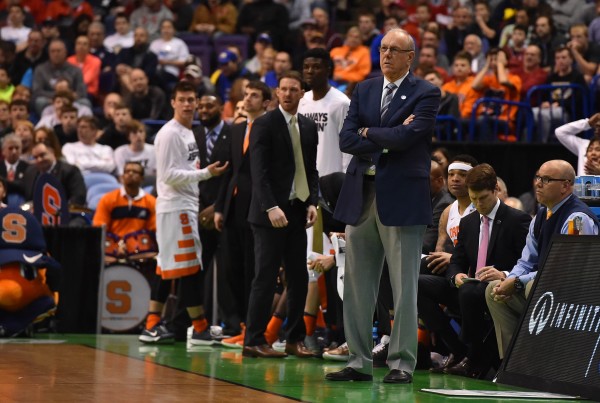ACC Crashes the Sweet Sixteen Party in Unprecedented Way
Posted by Brad Jenkins (@bradjenk) on March 23rd, 2016The ACC has advanced a record six teams into the Sweet Sixteen of this year’s NCAA Tournament, giving the league an impressive total of 11 appearances in the second weekend over the last two years. Last year’s placement of five ACC teams in the regional semifinals was only the second time a conference had put that many teams there (Big East — 2009), but this year’s sextet marked a new record for postseason conference superiority. There has since understandably been much discussion on how to contextualize this year’s performance, and we’ll weigh in on that question while examining its meaningfulness for the conference as a whole.
The ACC has gone through two major expansions in the last dozen years, poaching schools from the Big East in each case. At least dating back to the early 1980s, those two leagues (often along with the Big Ten) have waged battle for the prestigious title of best conference in college basketball. The league’s first round of additions (Miami, Virginia Tech, Boston College) in the mid-2000s were added for their prestigious football programs and lucrative television markets — the result was that the league’s status as first among basketball powers slumped. But the most recent ACC expansion north resulted in the acquisition of four good-to-great basketball programs. The arrivals of Syracuse, Louisville, Notre Dame and Pittsburgh sparked notions that the ACC could become the best basketball conference ever assembled. And so far, so good. After a shaky first year as a bulky 15-team league, the ACC has now logged two consecutive seasons of impressive postseason success. Two of the ACC’s six Sweet Sixteen participants this year are recent additions (Syracuse and Notre Dame), and a third newcomer, Louisville, would have certainly been a high seed had the Cardinals been eligible this year.
From a historical perspective, though, it’s a tough argument to say that the league is better than it was in the 1980s and 1990s. Consider that in the first six years of the expanded tournament — beginning in 1985, every team had to win twice to make the Sweet Sixteen — half of the ACC’s eight members made the second weekend of the NCAA Tournament on four separate occasions. If, however, we compare the league’s NCAA Tournament performance with several other power conferences this year, the results are extremely favorable.
 You can see from the table above that this year’s ACC benefited from facing lower seeds, particularly in the second round. But that argument only goes so far. The Big 12 and the Pac-12 held essentially the same advantage in its games but didn’t take care of business. Furthermore, in every case where an ACC team played a double-digit seed — #15 Middle Tennessee State; #14 Stephen F. Austin; #12 Yale; #11 Wichita State — the ACC team defeated a Cinderella that had proven too tough for the other power leagues to handle. Also note that all three Big 12 Sweet Sixteen teams played a Second Round game against an upset winner, so that league too came out with a pretty nice draw. Among this group, the Big Ten has logged the only wins over high seeds — Indiana’s victory over #4 Kentucky and Wisconsin’s buzzer-beating defeat of #2 Xavier, most notably.
You can see from the table above that this year’s ACC benefited from facing lower seeds, particularly in the second round. But that argument only goes so far. The Big 12 and the Pac-12 held essentially the same advantage in its games but didn’t take care of business. Furthermore, in every case where an ACC team played a double-digit seed — #15 Middle Tennessee State; #14 Stephen F. Austin; #12 Yale; #11 Wichita State — the ACC team defeated a Cinderella that had proven too tough for the other power leagues to handle. Also note that all three Big 12 Sweet Sixteen teams played a Second Round game against an upset winner, so that league too came out with a pretty nice draw. Among this group, the Big Ten has logged the only wins over high seeds — Indiana’s victory over #4 Kentucky and Wisconsin’s buzzer-beating defeat of #2 Xavier, most notably.
It’s also a bit premature to dub this year “the ACC’s Tournament.” Conferences are ultimately judged on the entire NCAA Tournament, with special praise delivered for those that make the Final Four. If none of the ACC’s six remaining teams advance to Houston, how successful a postseason will it really have been? This year’s Tournament has been largely devoid of matchups between the power conferences. Of the 40 games involving power conference members, only two ACC teams have played against another power conference team. In that pair of contests, the ACC and Big Ten split first round meetings – Notre Dame rallied past Michigan while Wisconsin survived Pittsburgh. But things are going to be different from now on. Counting Miami’s meeting with Villanova (Big East), five of the ACC’s upcoming Sweet Sixteen games will be against teams from the other power conferences. Only then will we know for certain whether this year’s first weekend results have any sustainability.











































